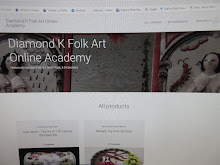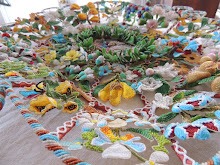mid 18th c Baby Bodice, 1128.2020.20
What a cunning little piece this one is! This bodice, as it is now, is typical of the period for a small child~ the cut being the same for a poor class or an elite class baby, with the only difference being the outer fabric. The further down the class scale one went, perhaps a little plainer fabric, less decorative details, that sort of thing....but not always, as clothing was always being sold at Vendu sales(18th c equivalent of our yard/garage sales), given to the poor ect. As evidence shows from thread remains at the waistline, this bodice has been unpicked from the skirting it once had. I have examined the area closely, and it looks to have been made up as a lined bodice first, then whipped to the skirting, as the lining is intact and not cut away, only the threads used to whip it to the skirts were cut.
I am leaving these big, as reducing them one cannot see the wonderful details of the vertical pleating on the front and back of the bodice. Dorset button back closure, with sleeves that would have reached down to the elbow of the wearer. I use a minimalist approach when it comes to storage. I do not wash unless the piece's structural integrity would be compromised otherwise....I do not steam or iron out wrinkles unless something is going on exhibit. I store all my items flat to reduce the most stress on the fibers. So here, to help ease out the bad creasing of years of being crumpled in the sleeve area, rolls of acid free towling have been inserted from neck to cuff. This helps to prevent flat crease folds at the shoulders, and support the sleeve at the same time. If you enlarge the picture, look closely at the over shoulder neck edge area. The band of fabric that goes up over the shoulder here, along the neck edge, is twice as wide as shown. I had unfolded the fabric with my fingers before inserting the towling, and upon inserting it, they folded right back in on themselves. The fold is greatly worn as well, which tells me, this happened when precious one was wearing it as well, so that is how they will remain in storage.
One thing I love about early clothing, is that, much like a fingerprint on paper...clothing forms to its wearer...like a body print, if you will.....providing details of how the piece was worn, how the wearer was able to move and function with the garment on.
I love the details in this piece~ tambour embroidery up center front, with wonderful drawn threadwork bands running aside it.
And then those broad bands of minute pleating, really amazing.
Here is a great close view of the Dorset buttons on the back closure
The construction is very simple~ just a band of cloth peaked up a little at the armscyes, with a strip running from back to front over the shoulder, that the sleeve is set in to. There are tiny, tiny eyelet holes at the very top of the lining, at each side of each armscye, for a drawstring adjustment along the neckline.
A gathering of pin holes can be easily seen center front of the lining, where other pieces of clothing were pin'd to this bodice, or the bodice pin'd to something underneath.
It's no wonder the skirting has been removed and reused at some point, the fabric is a gorgeous sheer hard cord muslin popular for caps and things at the time. Cord muslin came in three kinds~ hard(stiffened or dressed), soft and lawn.






























2 comments:
I can't imagine something like this being sold at a yard sale!! The WORK that went into it! AMAZING!!! LY, Mom
Wonderful!!
Post a Comment